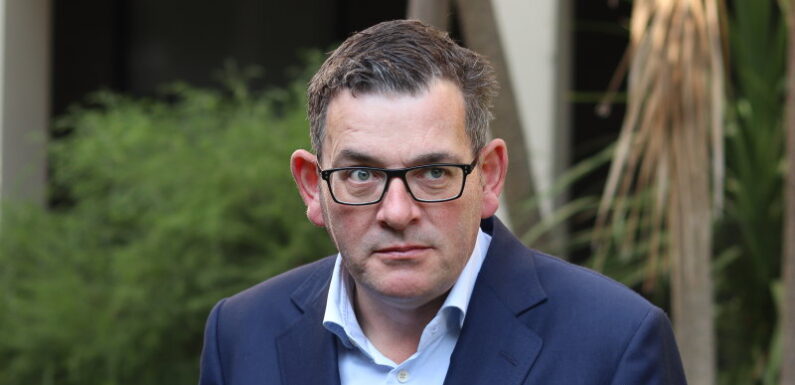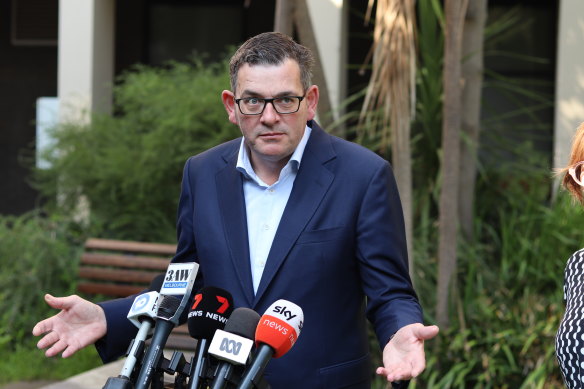
Save articles for later
Add articles to your saved list and come back to them any time.
There have been two notable developments in Victorian politics over the past week. First was the Independent Broad-based Anti-corruption Commission’s finding of improper conduct by the Health Department in the awarding of a contract to a union. IBAC’s report flagged concerns about intimidation of the public service by ministerial staff and centralisation of power in the premier’s office. Premier Daniel Andrews’ haughtily dismissive reaction to the report was as striking as its findings.
The second development was the latest Resolve Strategic poll which showed the Andrews government further extending its already commanding lead over the Coalition. It confirms an entrenched pattern of Labor dominance; indeed, of Victoria virtually being a one-party state.
Victorian Premier Daniel Andrews was dismissive of a corruption watchdog report that warned of centralisation of power in his office.Credit: Gus McCubbing
Labor’s ascendancy is a relatively recent phenomenon. Yet the history of Victorian politics is that the state has struggled to sustain a competitive two-party system.
For most of the 20th century, it was the ALP’s feebleness that militated against regular alternation of power between the Labor and non-Labor sides of politics. Its electoral strength confined to Melbourne’s industrial suburbs, Labor was cruelly penalised by an electoral system biased to rural and regional areas. The party was also dominated by Trades Hall, which was ideologically hidebound and had an oppositional rather than governing culture.
Victorian Labor’s chronic weakness looked to be finally at an end when in 1952 a watershed victory under the leadership of John Cain snr delivered the party its first experience of majority government. The state appeared on the cusp of an era of party competitiveness.
Alas, it was not to be. In 1955, the Cain government was destroyed by a split over the activities of Catholic anti-Communist militants. The split spawned the breakaway Democratic Labor Party which, by delivering watertight preferences to the Liberal Party, led by Henry Bolte, enabled it to win six consecutive elections between 1955 and 1970. Condemned to seemingly perpetual opposition, Labor was dominated by left-wing industrial unions and mostly uninterested in the compromises involved in winning government.
Transitions in the major parties in the 1970s, however, promised to deliver a new competitiveness to Victorian politics. Despair at Labor’s condition, which was hampering the ALP’s chances of forming national government, provoked federal intervention in the Victorian branch and led to an influx of middle-class progressives and policy modernisation. The Liberal Party, too, underwent a transformation in the 1970s after the retirement of the crusty conservative Bolte. He was succeeded by the genteel Rupert Hamer, a quintessential small “l” liberal.
Hamer won three elections but in 1982, Labor finally broke through to gain power under John Cain jnr. The government changed, but it was impossible not to notice ideological continuity between Cain’s modernising social democratic program and Hamer’s progressive liberalism.
After a fruitful decade of governance and three election victories, Labor was defeated when the party was beset by factionalism and the state’s economy was battered by financial calamities. The Liberal Party reclaimed office under Jeff Kennett, winning two elections in 1992 and 1996. The alternation of power between the Labor and Liberal parties in the final quarter of the 20th century appeared to signal that Victoria finally had a competitive two-party system.
Yet the 21st century has had a return to uncompetitiveness. Labor became supreme while the Liberals languished in opposition.
What happened? A feature of the 2022 election campaign was Labor’s promise to resurrect the State Electricity Commission. The popularity of the policy spoke to lingering community resentment at the Kennett government’s privatisations. Indeed, it’s reasonable to ask if Victorians have ever quite forgiven the Liberal Party for the aggressive neoliberal program it unleashed in the 1990s.
The Kennett era hurt the Liberals in another way. Kennett so overshadowed his party that a quarter of a century later, it hasn’t found anyone to fill his leadership shoes. True, Ted Baillieu led the party to government in 2010, but the progressive-leaning Baillieu was internally undermined and resigned less than three years into his premiership. Back in opposition since 2014, the Liberal Party is yet to produce a leader to trouble Andrews, another domineering premier.
The larger story of the modern Liberal Party’s uncompetitiveness is that commandeered by diehard conservatives, it has been philosophically out of alignment with most Victorians. A telling insight into its skewing to the right was an observation of a Liberal insider that most of the party’s branch members are Sky After Dark viewers. In vacating the moderate space, the Liberals have forfeited to Labor the progressive mantle in Victorian politics.
Why does it matter that Victoria has been unable to sustain a competitive two-party system? Put simply, alternations of government is one of the things that wards against concentrations of power. Premiers and governments that feel impervious to opposition are more likely to overreach. For disturbing evidence of this manifesting in Victoria, we have to look no further than the latest IBAC report and Andrews’ contemptuous reaction to it.
One offset to the current lopsided state of affairs at Spring Street is evidence of an evolution towards a multi-party system. Among younger voters, the Greens rather than the Liberals are the second party of choice after Labor. The trend away from the major parties portends a future in which government will have to be shared rather than what has been Victoria’s unhealthy habit of prolonged stretches of one-party domination.
The Opinion newsletter is a weekly wrap of views that will challenge, champion and inform your own. Sign up here.
Most Viewed in National
From our partners
Source: Read Full Article
